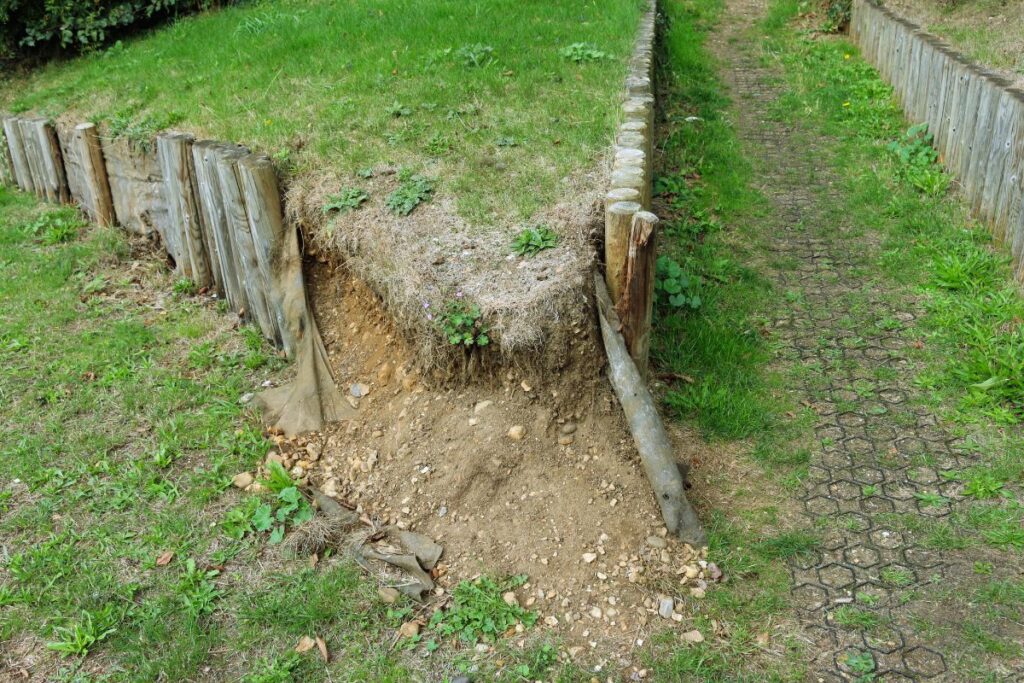Retaining wall failure is often caused by one thing: poor drainage. In St. Louis, where expansive clay soil and heavy seasonal rainfall are common, improper drainage design is a leading reason retaining walls crack, bow, or collapse prematurely. Homeowners are frequently surprised when their well-built wall begins leaning just a few years after installation. But in most cases, the issue didn’t start with the wall — it started with the water.
This article explains why drainage is essential for wall longevity, identifies the most common drainage-related mistakes specific to St. Louis, and outlines how to spot issues early. Whether you’re maintaining an existing wall or planning to build a new one, understanding drainage can save you from costly repairs and structural damage.
Why Is Drainage Essential for Retaining Walls?
Drainage protects your wall from water pressure. When water builds up behind a retaining wall with no place to escape, it creates hydrostatic pressure a powerful force that pushes against the structure. Over time, this pressure can cause walls to crack, bow, or even topple.

In St. Louis, the risk is higher due to:
- Expansive clay soils, which retain water and swell
- Frequent rainfall in spring and summer
- Improper grading on older residential lots
To prevent failure, every wall should include:
- Gravel backfill for quick drainage
- Perforated drainpipes (also called French drains)
- Weep holes at regular intervals for water escape
Without these, even a solid concrete wall will eventually fail.
What Drainage Mistakes Cause Wall Failure in St. Louis?
Poor drainage design is a hidden structural flaw. Many St. Louis retaining walls are built without attention to water flow, especially in older homes or DIY projects. The most common drainage errors include:
- Backfilling with clay instead of clean gravel
- No perforated pipe behind the wall to carry water away
- Missing or clogged weep holes, leaving water trapped
- Flat yard grading that channels runoff toward the wall
These problems are especially common in areas like Kirkwood, Webster Groves, and South City where landscaping has aged without modern water control techniques. Homeowners in sloped or hilly areas often need a retaining wall with proper drainage to control erosion and protect structures below. Learn more about custom retaining wall construction in St. Louis.
How Can You Tell If Your Wall Has Drainage Issues?
Yes, there are early signs your wall is failing. The symptoms of poor drainage usually appear subtly, then progress quickly after storms. Watch for these common indicators:
- Bulging or bowing in the wall’s midsection
- Water stains or efflorescence (white mineral deposits)
- Pooling water at the base of the wall after rain
- Moss or algae growing in damp areas
- Cracks or shifting blocks, especially horizontal ones
If your retaining wall shows any of these signs, it’s likely that water is trapped behind it — and it’s time for a professional inspection.
Why Is St. Louis Soil So Hard on Retaining Walls?
St. Louis has some of the most challenging soils in the Midwest. The dominant clay soils especially in areas like University City and Ballwin expand dramatically when wet and shrink when dry. This continuous movement creates shifting ground pressure that weakens walls over time.
Combined with:
- Heavy spring downpours
- Urban runoff in older neighbourhoods
- Freeze-thaw cycles in winter months
you get a situation where water consistently works against your retaining wall, especially when drainage is neglected. Many older walls in St. Louis fail not from poor materials, but from a lack of planning for how water behaves in our unique soil conditions.
How Do You Prevent Drainage-Related Wall Failure?
The best solution is proactive water management. Whether you’re repairing a wall or building a new one, the following measures are essential:
- Install a French drain behind the wall to carry water away
- Use clean gravel backfill instead of native soil
- Place weep holes evenly across the base of the wall
- Add geogrid reinforcement for extra stability
- Regrade the slope to redirect surface runoff away from the structure
These steps ensure that water doesn’t pool or push against your wall. For new projects, partnering with a contractor experienced in St. Louis retaining wall systems is crucial.
When Should You Call a Wall Drainage Expert?
Yes, early intervention saves you thousands. If you notice leaning, cracking, or soggy soil behind your retaining wall — especially after rain — it’s time to get a professional assessment. Delaying repairs can lead to:
- Wall collapse
- Landscape erosion
- Foundation damage if the wall is near a structure
Our team specialises in retaining wall repairs in St. Louis, offering long-term drainage solutions tailored to local terrain and property layouts.
Frequently Asked Questions
Do all retaining walls need drainage?
Yes. Every retaining wall over 3 feet tall must include drainage to handle water pressure. Without it, even reinforced walls can fail.
What’s the best drainage system for a retaining wall?
A French drain system combined with gravel backfill and weep holes provides the most reliable long-term solution.
How do I know if my retaining wall needs repair?
Look for signs of stress, including cracking, leaning, or soil erosion behind the wall. These typically indicate water is building up where it shouldn’t.
What’s Next? Protect Your Property With a Drainage Check
If your retaining wall is showing signs of stress, don’t wait until it collapses. The most common cause of wall failure in St. Louis is poor water management — and it’s completely preventable.
- Schedule a drainage assessment to catch issues early
- Upgrade existing walls with modern water control systems
- Work with local experts who understand St. Louis soil and climate
At Retaining Wall & Paving Solutions, we build smarter, longer-lasting walls that are made for Missouri terrain. Whether you need an inspection or a full rebuild, we’re here to help you protect your investment.